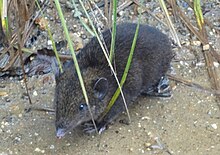Gymnure
 From Wikipedia the free encyclopedia
From Wikipedia the free encyclopedia
This article needs additional citations for verification. (September 2011) |
| Gymnures[1] | |
|---|---|
 | |
| Bornean short-tailed gymnure | |
| Scientific classification | |
| Domain: | Eukaryota |
| Kingdom: | Animalia |
| Phylum: | Chordata |
| Class: | Mammalia |
| Order: | Eulipotyphla |
| Family: | Erinaceidae |
| Subfamily: | Galericinae Pomel, 1848 |
| Genera[5] | |
| |
Gymnures, also called hairy hedgehogs or moonrats, are mammals belonging to the subfamily Galericinae, in the family Erinaceidae and the order Eulipotyphla. Gymnures resemble rats but are not closely related as they are not rodents; they are instead closely related to hedgehogs, which also belong to Erinaceidae. They are thought to have appeared in Eastern Asia before their closest relatives, and changed little from the original ancestor, which is thought to have been also the ancestor of the shrews.
Description
[edit]Although the gymnures are more closely related to the hedgehogs, full-grown gymnures superficially resemble large rats, shrews, and opossums.
The gymnure's body plan is believed to resemble that of the earliest mammals,[citation needed] with a large, toothy head about 1/3 the length of the total body, a naked furless tail for balance and thermoregulatory purposes, and a plantigrade stance. In direct contrast to the closely related hedgehogs, gymnures are not spiny.[6]
They also have an outstanding sense of smell, and tactile response in the snout region.
Distribution and habitat
[edit]Gymnures inhabit moist jungle terrain in various locales of Southeast Asia, including Vietnam, Sumatra, China and the Malay Peninsula.
Behaviour
[edit]Gymnures are primarily carnivorous. They are nocturnal or crepuscular: they come out to forage at twilight or in the night to search the forest floor, using smell to find the animals that they eat. Gymnures eat various arthropods, mice, small reptiles and amphibians, with occasional fruit and fungi.
Gymnures keep territories, and individuals are solitary except when breeding. Gymnures have a very strong scent, typically described as a rancid garlic or onion smell, which is produced by its territory-marking scent glands. Several creatures similar in form and niche, such as the opossum and solenodon, have an odor similar to the gymnure's.
Classification
[edit]This subfamily has alternately been called Echinosoricinae, Galericinae, and Hylomyinae. Some researchers prefer Hylomyinae because the specific relationships of the extinct genus Galerix to living erinaceids are uncertain.[7] There are fifteen extant species in six genera:[1][8]
- Genus Echinosorex
- Genus Hylomys
- Genus Neohylomys
- Neohylomys hainanensis (Hainan gymnure or Hainan moonrat)
- Genus Neotetracus
- Genus Otohylomys
- Genus Podogymnura
- Podogymnura aureospinula (Dinagat gymnure or Dinagat moonrat)
- Podogymnura intermedia (Eastern Mindanao gymnure )
- Podogymnura minima
- Podogymnura truei (Mindanao gymnure or Mindanao moonrat)
References
[edit]- ^ a b Hutterer, R. (2005). Wilson, D.E.; Reeder, D.M. (eds.). Mammal Species of the World: A Taxonomic and Geographic Reference (3rd ed.). Johns Hopkins University Press. pp. 212–217. ISBN 978-0-8018-8221-0. OCLC 62265494.
- ^ Masini, F.; Fanfani, F. (2013). "Apulogalerix pusillus nov. gen., nov. sp., the small-sized Galericinae (Erinaceidae, Mammalia) from the "Terre Rosse" fissure filling of the Gargano (Foggia, South-Eastern Italy)". Geobios. 46 (1–2): 89–104. doi:10.1016/j.geobios.2012.10.008.
- ^ Jiménez-Hidalgo, E.; Guerrero-Arenas, R.; Crespo, V. D. (2022). "First galericine erinaceid (Mammalia: Eulipotyphla) from the early Oligocene of tropical North America". Historical Biology: 1–6. doi:10.1080/08912963.2022.2070018. S2CID 248467861.
- ^ van den Hoek Ostende, L. W. (2003). "Riddleria atecensis nov. gen. nov. sp., a peculiar erinaceid (Erinaceomorpha, Mammalia) from the Lower Miocene of Spain". Beiträge zur Paläontologie. 28: 1–11.
- ^ Lopatin, A. V. (2006). "Early Paleogene insectivore mammals of Asia and establishment of the major groups of Insectivora". Paleontological Journal. 40 (S3): S205–S405. doi:10.1134/S0031030106090012. S2CID 84144565.
- ^ Feldhamer, George [and 4 others] (2015). Mammalogy: Adaptation, Diversity, Ecology, Edition 4. Baltimore: Johns Hopkins University Press. p. 285. ISBN 978-1-4214-1588-8.
{{cite book}}: CS1 maint: numeric names: authors list (link) - ^ Gould, G.C. (1995). "Hedgehog phylogeny (Mammalia, Erinaceidae) – the reciprocal illumination of the quick and the dead". American Museum Novitates (3131): 1–45. hdl:2246/3665.
- ^ Hinckley, A.; Camacho-Sanchez, M.; et al. (2023). "An integrative taxonomic revision of lesser gymnures (Eulipotyphla: Hylomys) reveals five new species and emerging patterns of local endemism in Tropical East Asia". Zoological Journal of the Linnean Society: zlad177. doi:10.1093/zoolinnean/zlad177.